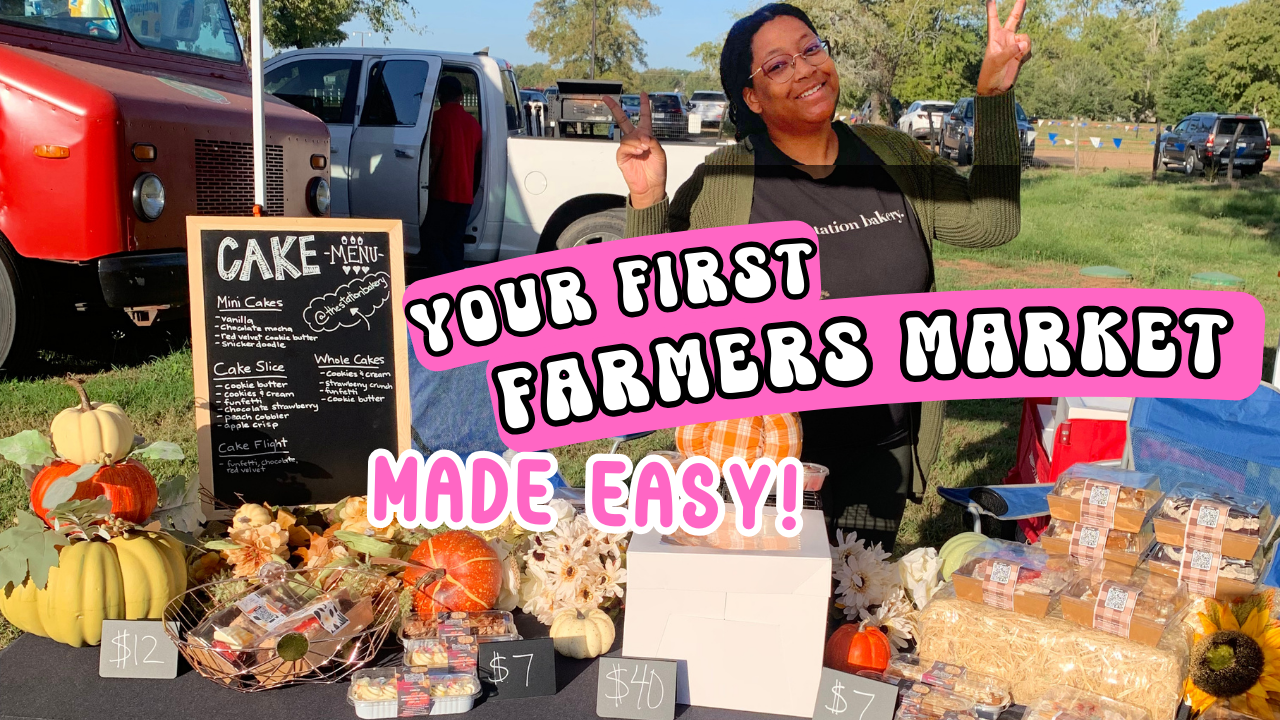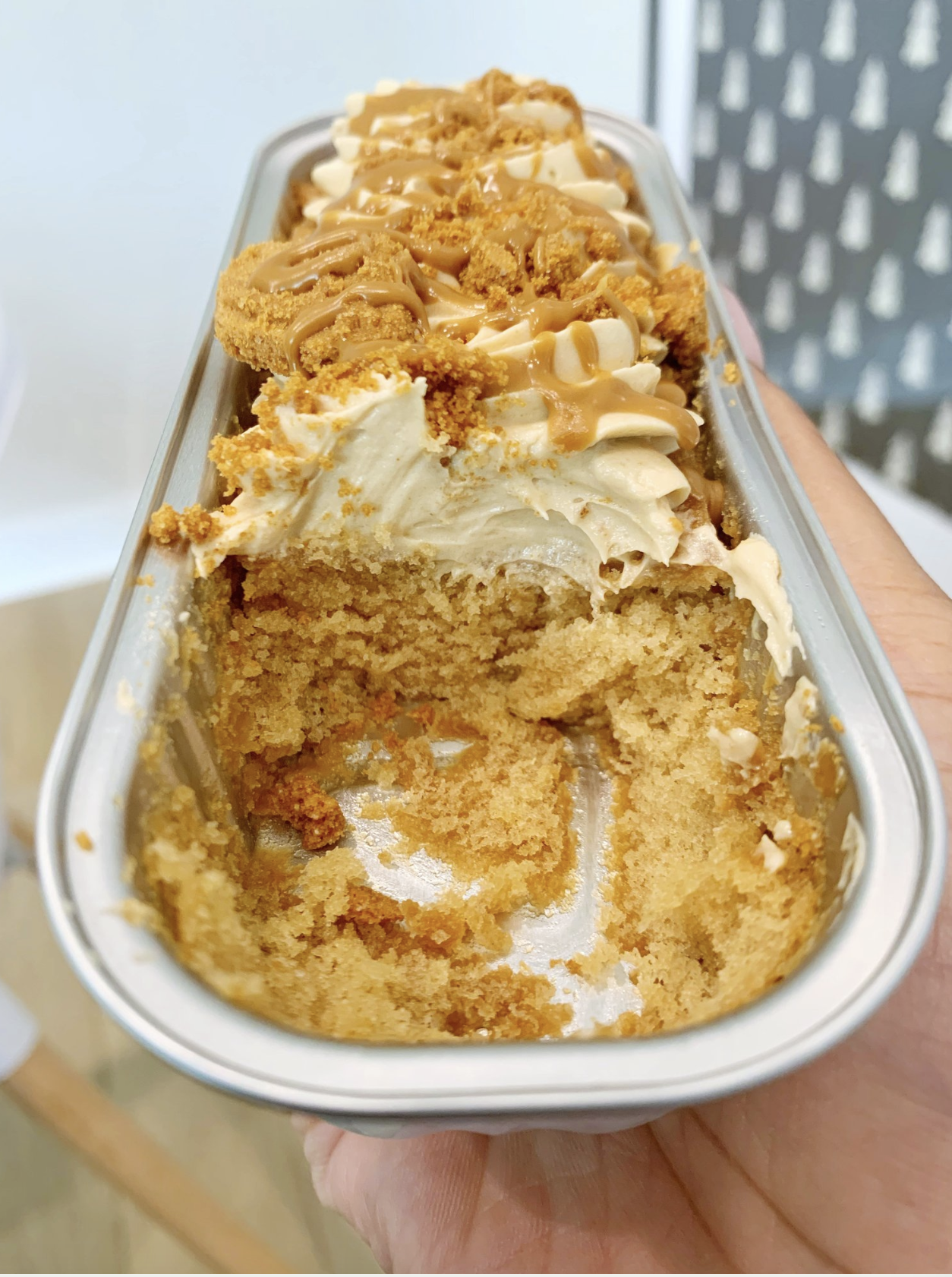How to Prepare for Your First Farmers Market: A Step-by-Step Guide
Selling your baked goods at a farmers market can be exciting and daunting at the same time. As a home baker, you already know your family and friends love your recipes. Now it’s time to take the next step and share your cakes and treats with a larger audience at your first farmers market.
I remember my first farmers market experience. I was nervous, but gained so much confidence in my products seeing customers enjoy and praise them. However, I also learned that preparation is key for a successful market day. There are a few steps to ensuring you're ready to make the most of your first farmers market from understanding legal requirements to setting up an inviting booth.
In this guide, I’m going to walk you through each step to prepare for your market, sharing tips and insights from my own experience. Whether you’re a seasoned baker or just starting out, this guide will help you prepare to sell at a farmers market so you can focus on what you do best: baking delicious treats that makes people’s day a bit sweeter.
Step 1: Research and Choose the Right Farmers Market
Step 2: Understand Legal Requirements for Selling at a Farmers Market
Step 3: Plan What to Sell at Farmers Market
Step 4: Prepare Your Farmers Market Setup
Step 5: Market and Promote
Step 6: Market Day Preparation
Research and Choose the Right Farmers Market
Choosing a farmers market that aligns with your needs and goals is crucial to your success as a home baker. Here are some tips to help you find the best match for your baked goods.
Identify Local Farmers Markets
Start by researching farmers markets in your area. You can do this by searching local Facebook groups and community pages, Google Maps, search “farmers markets + your location” in Google and social media, and your city’s official website. Compile a list of potential markets.
Evaluate Market Fit
All farmers markets are NOT created equally. So consider the following factors to choose a market that best aligns with your home bakery’s goals.
👉🏽 Location: Choose a market that is convenient for you and one your target customers will likely attend.
👉🏽 Customer Demographics: Attend the markets to see what kind of customers shop there. Consider if they would be interested in your baked goods. Think flavors, concepts, and price point. You can also reach out to the market coordinator for more information.
👉🏽 Market Size and Competition: Larger markets may have more foot traffic (the amount of people that attend), but can also have more competition for you.
Smaller markets can foster a more intimate setting allowing you to get to know your customers better and have less competition. But they can also limit your profits, so ensure the possibility to meet your goals is there.
👉🏽 Market Fees: Compare vendor fees for each of the markets. Some markets will charge a flat fee per market and others will take a percentage of your total sales. Consider which options align best with the goals for your home bakery business.
Visit Markets
Before you commit to a market, visit them in person a few times. This will give you a real life look into the vibe of the markets, foot traffic, types of customers, potential competition and price ranges. You will also have the opportunity to talk and make connections with other vendors. You can ask them questions and get the real scoop on the market.
Understand Market Rules and Regulations
Not only does each state have its own set of rules when it comes to what’s allowed for home bakers, each market can have its own set of rules and regulations as well. Here are a few things to get an understanding on, before attending your first farmers market.
✅ Permits and Licenses: Ensure you have all required permits and licenses to sell your baked goods, by checking your local state and county cottage food laws. This may include a food handler’s permit and/or a business license.
✅ Product Restrictions: Some states have restrictions on the products you can legally sell and markets may have their own restrictions (may limit types of products able to be sold to ensure fairness for all vendors), so be sure to become familiar with what is accepted and verify that your baked goods meet the criteria.
✅ Booth Requirements: Understand what is required by each market for your booth setup, including tent size, signage, and display guidelines.⭐️
Assess Market Potential
Consider the potential for growth and repeat customers at each market. Look for markets that have a loyal customer base.
By thoroughly researching and choosing the right farmers market, you can set yourself up for success, maximize your sales, build a loyal customer base, and reach the right audience that can help grow your home bakery business.
Understand Legal Requirements for Selling at a Farmers Market
Being familiar with the legal requirements is essential for home bakers selling at farmers markets. Here are a few tips to ensure you comply with all necessary regulations.
Cottage Food Laws
Research your local cottage food laws. Each state has its own set of cottage food laws that dictates what home bakers can sell. For example, here in Texas, the Cottage Food Law allows the sale of non-potentially hazardous foods like baked goods, treats, candies, jams, and jellies. Other products that require refrigeration like cheesecake or pumpkin pie are not allowed.
Side note: Despite some unpopular belief, we, in Texas, can actually sell items that include ingredients that need refrigeration like cream cheese buttercream as long as the final product does not require refrigeration.
Permits and Licenses
Obtain the necessary permits and licenses to legally sell at a farmers market. This may include a food handler’s permit and a business license.
You may also need to register with your local health department if required.
Each market may have different requirements for what’s necessary to sell there, so always reach out to the market coordinator to know for sure.
Liability Insurance
While it is not always required to sell at a farmers market, having food liability insurance is something I strongly recommend to protect you in the case there are any issues related to your products. I personally use Food Liability Insurance Program (FLIP).
Labeling Requirements
Label your products with all required information. You will need to check your states law to ensure all aspects are covered. Here in Texas, we must include name of product, business name, address, allergens, and a statement that the food is made in a home kitchen. You can check out an example if what’s required for Texas cottage food laws here and you can purchase my cake label templates that make labeling your baked goods easy and functional while still looking good here.
A few other states require the above plus listing all ingredients and business license number.
By understanding and adhering to these legalities, you’ll ensure that your home bakery will will run smoothly and legally at the farmers market plus it can help you build trust with customers knowing you are taking every step necessary to provide them with a delicious and safe product.
Plan What to Sell at Farmers Market
Creating a well thought out plan for what to sell at farmers market is important for attracting the right customers and maximizing your sales.
Select Your Baked Goods
🍰 Best-Selling Items: Start with a few of your best-selling baked goods and flavors that you know are popular. If you don’t know what your best sellers are or don’t have any because you’re just starting out, just consider a few commonly popular items like cookies, muffins, cakes, and breads.
For me, this was mini cakes. I was having great success and feedback from my mini cakes in previous custom orders so I was sure to bring those. I also knew cake slices and cake flights would do well too.
For flavors, there was never a chance I would leave out cookie butter or chocolate as those have been crowd pleasers for me for a while.
🍰 Seasonal Offerings: Incorporate seasonal ingredients for relevancy and to create limited-time offerings. For example, pumpkin spice muffins for the fall or lemon berry honey butter crunch cupcakes for the summer.
🍰 Unique Items: Offering unique items that may be new or not commonly offered to your market can help you stand out. You can also consider selling gluten-free or vegan baked goods.
Pricing Strategy
Calculate the cost of ingredients, packaging, labor and profit to determine your pricing. You can use my cake pricing calculator and learn hows to price your baked goods for a farmers market here.
You can also research the prices of similar products at the market to ensure your prices are competitive yet profitable.
Packaging and Labeling
Use attractive packaging that’s functional, appealing and cost effective. Clear bags and boxes with proper labeling materials enhance the presentation of your baked goods. Remember, we eat with our eyes first.
Inventory Management
Based on your research and previous sales, estimate how much of each product you should bring to the market.
Keep records of what sells and what doesn’t to help you adjust for future markets.
Carefully planning what to sell at the farmers market will help you offer a variety of baked goods that are sure to attract customers and make sales.
Prepare Your Farmers Market Setup
Create an inviting and efficient booth setup to attract customers and maximize your sales at the farmers market. Here’s how you can prepare your booth setup effectively.
Essential Equipment for the Farmers Market
Tables and Tents: Invest in a sturdy table or two and a reliable tent. Don’t want it to blow away and cause injury to others… A 10x10 white tent is a popular option for most farmers markets.
Display Stands: Use display stands to showcase your baked goods and make them more visually appealing and organized.
Signage: Include clear and attractive signs to make understanding what you sell easy. You can include things like your business name, product names, and prices.
You can shop my farmers market essentials here (may contain affiliate links)
Practical Considerations
Weather: Be prepared for whatever the weather may throw at you. Bring tent weights, tarps and even fans as needed.
Payment Methods: Be prepared with various ways customers can pay. This includes having cash on hand and a way to take digital payments. I use Square.
Sanitation: Keep hand sanitizer, gloves, wipes, trash bags and a trash can on hand to maintain a clean space.
Customer Engagement
Engage with your customers in a natural way. This can be as easy as saying hello or giving a smiling nod to everyone who passes by.
Handing out samples (a huge game changer) is another easy way to engage with potential customers and start a natural conversation about your products.
Be approachable and try to refrain from being on your phone or distracted. This is a sure way to lose customers before you even gain them.
Preparing your farmers market setup using these tips can help you create an inviting and professional space.
Market and Promote
Effective marketing and promotion is key to attracting customers to your booth and building a loyal customer base at farmers markets.
Social Media
Use social media to engage with your audience and announce your market appearances.
Create a business page and join local community groups to promote your market schedule and offers. Interact and share photos and updates regularly.
Here’s some content ideas for you to post:
behind the scenes
baking processes
customer testimonials
Email Marketing
Keep your audience informed with regular newsletters that include updates on your market schedule, new products, and promotions. You can collect emails at your farmers market and through your website.
Local SEO
Optimize your website for search by using local keywords like “Houston farmers market baker” to improve your Google search ranking. Make sure you choose a website host that is mobile friendly and easy to use.
Also consider creating a Google My Business profile and encourage customers to leave reviews to boost your local search visibility.
Networking and Collaborations
Collaborate with other local vendors to cross-promote products. Coffee vendors pair well with baked goods!
You can also attend local community events to increase your visibility and network with potential customers and partners.
Customer Engagement
You can increase customer engagement by providing samples of your baked goods to attract customers and if they’re good, encourage purchases.
Loyalty programs are also great ways to reward customers for purchasing with you.
Traditional Marketing
Don’t sleep on what’s tried and true.
Consider using flyers and business cards to distribute at the farmers market, local businesses, and just as you go about your day to day.
You can also reach out to local newspapers, magazines and TV stations to get a feature for your home bakery. Be sure to share your story and market schedule to gain exposure.
Market Day Preparation
The day of the farmers market can be both exciting and hectic. Being preapred help evryhtn grun smoothly and allows you to focus on engaging with customers and selling your baked goods.
Here’s a general checklist to help you prepare:
Before the Market:
your baked goods
display equipment/stands
payment methods
sanitation supplies
marketing materials
arrive early
be efficient
make display attractive
During the Market:
greet customers
offer samples
engage and share about your products
be prepared for cash and digital transactions
track sales
After the Market:
have an efficient pack up plan
take notes on what worked and what didn’t for next time
Conclusion
Preparing for your first farmers market can be a rewarding and profitable experience. By following these steps, you’ll be well-equipped to navigate the challenges and make the most of this exciting opportunity.
I hope this guide has provided you with valuable insights and practical tips to help you succeed at farmers markets. If you have any questions or need further assistance, feel free to reach out. Happy baking and best of luck at your first farmers market!












